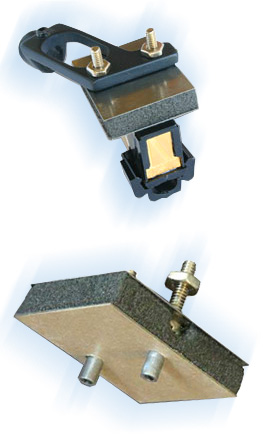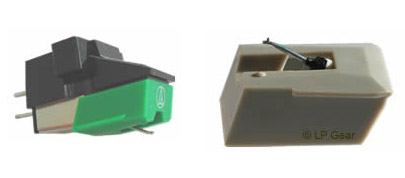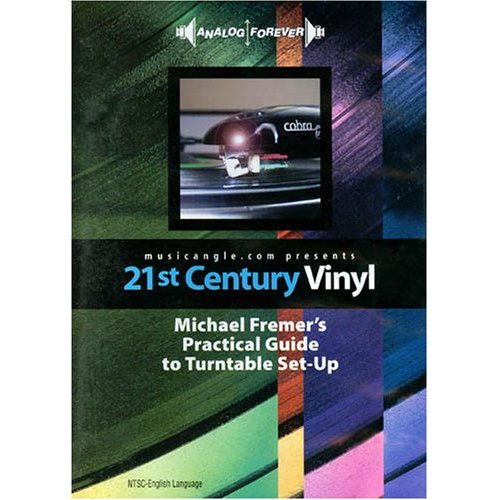Four Must-Have Analogue Items from The Cartridge Man, LP Gear-Audio Technica, and Michael Fremer
| Four Must-Have Analogue Items from The Cartridge Man, LP Gear-Audio Technica, and Michael Fremer |
|
|
|
March 2007 |
The Cartridge Man New Phono Cartridge Isolator: $150
 There are products that cause you to slap your forehead and cry “Duh! I should have thought of that!” They seem so simple and obvious in retrospect that one wonders why no one did it before. The DNM/Reson Ringmat, for example, evokes this response: a simple-looking replacement platter mat, constructed of parchment paper and cork rings, that gets to the heart of the LP/platter interface byisolating the LP from the platter, strategically damping the record’s resonances and dumping the overflow into the air.
There are products that cause you to slap your forehead and cry “Duh! I should have thought of that!” They seem so simple and obvious in retrospect that one wonders why no one did it before. The DNM/Reson Ringmat, for example, evokes this response: a simple-looking replacement platter mat, constructed of parchment paper and cork rings, that gets to the heart of the LP/platter interface byisolating the LP from the platter, strategically damping the record’s resonances and dumping the overflow into the air.
Leonard Gregory, aka The Cartridge Man, has introduced a new, improved version of his original Isolator, a device that certainly induces fore-heading slapping and loud “Duh” expletives. Designed to serve as a mechanical filter that isolates the cartridge from the headshell and thus the arm, The Isolator eliminates the non-signal related energy generated from the physical tracing of the LP groove from entering the arm and exciting its resonances, and keeps any spurious energy from reflecting back down the arm and affecting the cartridge. The Isolator consists of two metal plates into which is sandwiched an exotic, and unfortunately expensive, loss-y damping material. The sonic effect is equivalent to doubling the quality of the tonearm, producing LP sound that eliminates most of the mechanical distortion signatures of LP playback, moving it closer to that of the master tape.
I awarded The (original) Isolator a Most Wanted Component Award. (Please see my original review for full coverage – HERE ) It’s brilliant, simple, and effective. So much so that many forehead slappers vaingloriously and erroneously felt that they could duplicate it for pennies. “Let’s see, I’ll just get some Super Glue, stick some Gouda cheese in between and ‘Voila!’ Uh, wait a minute, maybesmoked Gouda is better. Or maybe I should try some Camembert…”
The Cartridge Man’s New Isolator incorporates an even more exotic and expensive damping material called ‘micro-spiralex’, which together with the original material results in a now double-damped ‘meat’ of the sandwich. Given the expense of the damping materials, it is good news that Gregory was able to keep the price at $150. Perhaps the easiest way to describe The New Isolator’s effect is that it makes the original device sound equivalent to not using The Isolator at all. The improvement is that great. All the great things that the original Isolator did are magnified with The New Isolator to a level that I didn’t think possible.
There’s a grace, ease, and vividly natural portrayal of sonic and musical information that raises LP performance even higher into the stratosphere, and makes the gulf between LP and CD as deep as the Mariana Trench. The degree of perfection of human technology is how closely its artifice approximates Nature: an LP system incorporating The New Isolator, along with state-of-the-art physical isolation of the turntable itself, gets tantalizingly close to this natural ideal. The $150 New Isolator is the biggest improvement one can make to an already good turntable/arm: the resulting sonic and musical gains make it an absolute steal. Congratulations again to Mr. Gregory for continually creating products that truly open up the art of music.
(Check The Cartridge Man’s US distributor – AudioFeil International: ( http://www.audiofeil.com) for availability.
The Audio Technica AT95E ($49.95) and LP Gear AT95SA ($79.95) Moving Magnet Phono Cartridges

The tragedy of cheap phono cartridges (and these two Audio Technicas available exclusively from LP Gear certainly qualify) is that they are likely to be used with cheap turntables and arms, and amplified by cheap phono stages, thus giving a false picture of their true capabilities.
The Audio Technica AT95 series of cartridges has a long OEM history: the old Linn Basik (given away free to buyers of Linn turntables and arms to encourage buying one of Linn’s better arms) was an AT95 equipped with a spherical stylus. Linn’s hierarchy of LP playback importance ran: turntable, then arm, then phono stage, and, finally, the cartridge. Linn’s argument was that a better arm with a cheaper (‘worse’) cartridge will sound better than a poorer arm with an excellent expensive cartridge. A UK “Linnie” reviewer ran into a lot of flak some time ago when he claimed that the Basik cartridge “blew away Koetsus.” What he meant was not that the spherical-tipped AT95 cartridge was better than the Koetsus in purely sonic terms, but that it communicated the message of the music better – better timing, rhythm, flow, and punctuation.
LP Gear is the Internet retail arm (http://www.lpgear.com) of Starbrandz Networks (nee Elex Atelier), the US distributor of the superb Graham Slee phono stages. These two AT95 variants are warranted by LP Gear rather than by Audio Technica USA. The AT95E uses an elliptical stylus, the $30 more expensive AT95SA, developed by LP Gear, uses a Shibata stylus. The Shibata stylus is the progeny of the old JVC discrete 4-channel LP format, one that carried the additional two channels of information in a 30 KHz sub-carrier. The Shibata stylus was developed to de-code that high-frequency carrier and thus paved the way for wide bandwidth, line-contact stylus development.
As you might expect, both cartridges deliver superb musical timing, drive, tempo and rhythm: they get the essence of all music right. That essential sense of musicians playing together to communicate a musical message, one of the great advantages LP holds over CD, is fully captured. Bass is tight and well-controlled, with great pitch differentiation, and dynamic drive. One weakness of cheap turntables, especially when not isolated from environmental physical vibration, is in bass control. The two AT95’s will not compound the problem.
The AT95E integrates the range of the sonic bandwidth very well: no part of the spectrum sticks out at the listener. It doesn’t sound bright and it doesn’t sound dull at the top frequencies. Midrange is clear and detailed with no spittiness on vocals, though really cheap and inadequate analog match-ups will cause an slight upper mid-range burr. Hint: stay away from cheesy Japanese direct-drive turntables and the equally cheesy phono sections of the past.
Due to its strong rhythmic performance and excellent timing, the AT95E excels with Pop, Rock, and Jazz recordings. It is slightly less successful with orchestral music as the demands of re-creating complex instrumental timbres demand a lot out of any cartridge. While the AT95E’s portrayal of acoustic instrumental timbre sounds more natural than that of the CD, one can hear its limits of resolution. It never gets harsh or nasty, it just lacks some discrimination. It is, after all, a $50 cartridge.
The $30 additional cost of the LP Gear AT95SA and its Shibata stylus gets you more high frequency detail and resolution, without any attendant artificial brightness or edge. High frequencies sound silky and sweet, yet still cast clarifying light on the frequencies below, sharpening timbral acuity and bringing out more detail and nuance of performance. The basic rhythmic skills of the AT95E are not compromised, are, in fact, improved, as the AT95SA sounds even quicker on its feet and is more capable of rendering subtleties of performance technique. The increase in bandwidth and resolution clarifies orchestral instrumental timbre significantly, thus making Classical LP’s as communicative as Rock and Roll albums.
I played the two cartridges on six different turntables: my antique Connoisseur BD2A, the cheap and cheerful new Rega P2, two Linn Sondek LP12s and my two Origin Live reference tables. I also used seven different phono sections. Linn’s old rule-of-thumb that the cartridge is the least important part of an LP playback system still holds largely true, augmented now by the importance of turntable isolation devices and replacement platter mats. As I played the two cartridges in ever-more highly resolving gear it was clear that any sins committed by these two superb value cartridges were those of omission rather than active commission. They simply ran out of resolution, lacking that ultimate speed, focus and detail that the best, and necessarily more expensive, cartridges have. Still, even in my ‘reference’ LP system the two cartridges’ excellent musical communication skills allowed for deep listening satisfaction.
Those on a very tight budget or those building an inexpensive analogue LP front end need look no further than the $50 Audio Technica AT 95E. It’s well worth squeezing out another $30 for the AT 95SA, however, to gain its more extensive high frequency response and clarity. The AT95SA becomes my reference for inexpensive cartridges. Both cartridges are highly recommended.
Michael Fremer’s “Practical Guide to Turntable Set-Up” DVD

I often receive e-mails from readers interested in LP playback who live in areas without any dealers who can set-up a turntable and install a cartridge correctly. Many are intimidated by doing the job themselves. Despite my encouragement that the job is not that difficult – after all, even I, with the innate mechanical aptitude of Curley of The Three Stooges, have mastered it – many remain doubtful. I’ve often wished for a do-it-yourself instructional video that walked the neophyte through the process step-by-step. Michael Fremer, that grand enthusiast of the LP, has created just such an instructional DVD. Thank you, Mikey!
Retailing at just over $30, Mister Mikey’s Practical Guide to Turntable Set-Up is over three hours long and features a generic step-by-step guide to installing a cartridge and setting up a tonearm. The DVD repeats the process with three specific popular turntables, and also includes an interview with LP mastering engineer George Marino. A PDF file in a DVD-ROM section claims to get into even more detail: I was unable to find or access it with my DVD player.
One picture is worth a thousand words when it comes to giving instructions. Those setting-up a turntable for the first-time can watch and re-watch sections of The Practical Guide until they’re clear about what needs to be done and how to do it. There are many helpful hints too: re-sizing headshell leads to fit the cartridge pins, for example. Using the Fremer video will allow anyone to set-up their turntable up correctly, and thus become masters of their technology, independent of outside aid to keep their tables running up to snuff. The Practical Guide to Turntable Set-Up is a godsend, and long overdue. Deep thanks to Michael Fremer for producing this tool.
While fairly professional in production technique and common-sense in its attitude, The Guide does raise some quibbles. These quibbles focus on the ancillary tools Fremer uses in his demonstrations. The reliance on digital stylus-force gauges and the excellent WallyTools set-up tools are likely to be out of the price range of the average turntable user. It would have been more useful if really inexpensive tools were used, e.g., the Shure SFG-2 stylus gauge (used in its ‘x 2’ scale) and inexpensive alignment protractors (like the excellent $20 device available from Turntable Basics –http://www.turntablebasics.com)
My other quibble is major and it concerns setting the VTA/SRA correctly. In an attempt to not be too intimidating and discouraging to the neophyte, the Guide pretty much ignores this crucial set-up step, repeatedly commenting that you have to change the arm height excessively to change the VTA/SRA slightly. Since all cartridges need to have this parameter set accurately, and cartridges equipped with exotic and line-contact stylus profiles are absolutely dependent on it for proper operation, glossing over this crucial procedure (or worse, suggesting that it can be adjusted by altering the stylus tracking force) is, to my mind, a major oversight. This is especially true since The Ringmat LP Support System has long been available and solves the VTA/SRA set-up problem simply and brilliantly. (See – HERE ) To the turntable user, investment in the Ringmat System pays a far greater dividend than would investing in a digital tracking force gauge.
I also find it unfortunate that record and stylus cleaning, and general LP care and storage aren’t covered. So perhaps I yearn for a Complete Guide to Turntable Set-Up and Use. For Dummies. For right now, though, the Fremer DVD is essential.
(Should The Practical Guide not be available locally, it is available from the major mail-order/Internet LP specialist firms. Check Acoustic Sounds, Music Direct, Elusive Disc, or The Needle Doctor.)
Paul Szabady
![]()
Don’t forget to bookmark us! (CTRL-SHFT-D)
Stereo Times Masthead
Publisher/Founder
Clement Perry
Editor
Dave Thomas
Senior Editors
Frank Alles, Mike Girardi, Russell Lichter, Terry London, Moreno Mitchell, Paul Szabady, Bill Wells, Mike Wright, and Stephen Yan,
Current Contributors
David Abramson, Tim Barrall, Dave Allison, Ron Cook, Lewis Dardick, John Hoffman, Dan Secula, Don Shaulis, Greg Simmons, Eric Teh, Greg Voth, Richard Willie, Ed Van Winkle, Rob Dockery, Richard Doron, and Daveed Turek
Site Management Clement Perry
Ad Designer: Martin Perry





Be the first to comment on: Four Must-Have Analogue Items from The Cartridge Man, LP Gear-Audio Technica, and Michael Fremer